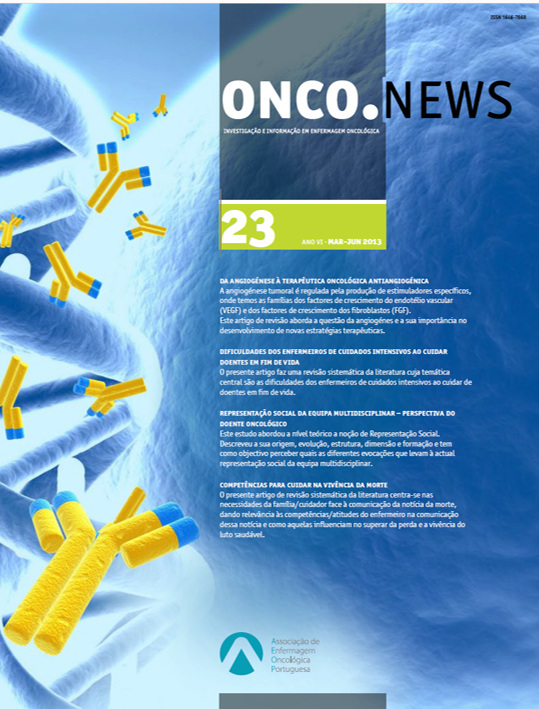Difficulties of intensive care nurses in caring for patients at the end of life
DOI:
https://doi.org/10.31877/on.2013.23.02Keywords:
intensive care, end of life, obstacles, death, communicationAbstract
Objective: Identify the main problems/obstacles of intensive care nurses to care for patients in end of life; Identify some measures that facilitate the provision of such care.
Methodology: For the preparation of this work were selected 5 articles from an initial sample of 29 withdrawn from EBSCO database. The methodology used was the PI C OD.
Results: The main obstacles identified by the ICU nurses to care for patients in end of life are related to the communication of information about the patient’s condition, use of aggressive treatments and procedures, disagreement about the plan of care, angry families and families that do not understand the prognosis.
Conclusions: The main findings of this article shows that the nurses of the ICU have the perception of the barriers to care for patients in end of life and that the integration of palliative care in intensive care will be an advantage.
Downloads
References
Lourenço, S. & Cunha, T. (2006). Cuidar em fim de vida - impacto nos profissionais http://www.scribd.com/doc/2454684/Cuidar-em-Fim-de-Vida-Impacto-nos-Profissionais.
Ciccarello, G. (2003, September). Strategies to improve end-of-life care in the intensive care unit. Dimensions of Critical Care Nursing, 22(5), 216-222. Retrieved April 18, 2009, from CINAHL Plus with Full Text database.
Hennezel, M. (2001) A arte de morrer (3.ª ed). Lisboa: Editorial Noticias.
Silva, G. F. da S., Sanches, P. G., Carvalho, M. D. de B. (2007) - Reflectindo sobre o cuidado de enfermagem em Unidade de Terapia Intensiva. In: Revista Mineira de Enfermagem. Belo Horizonte. Vol. 11, nº 1 (Jan.- Mar. 2007), p.1-9. Disponível em:
www: http://www.prtalbvsenf.eerp.usp.br/scielo.php?sript=sci_arttext&pid=S1415-27622X>. ISSN 1415-2762.
Marques, P.& Vieira, M. (2007). Princípios éticos gerais no agir em enfermagem: condicionamentos à intervenção de enfermagem promotora de dignidade das pessoas em fim de vida internadas em unidades de cuidados intensivos. S.Camilo. 1 (2). p.45-55. Disponível
em: http://www.scamilo.edu.br/pdf/bioethikos/57/Principios_eticos_gerais_no_agir_em_enfermagem.pdf
Gross, A. (2006, March). End-of-life care obstacles and facilitators in the critical care units of a community hospital. Journal of Hospice & Palliative Nursing, 8(2), 92-102. Retrieved April 18, 2009, from CINAHL Plus with Full Text database.
Tager, D. K. (2001) Viver a morte. Lisboa: Estampa.
Asch, D., Shea, J., Jedrziewski, M. & Bosk, C. (1997). The limits of suffering: critical care nurses views of hospital care at the end of life. Soc Sci Med, 45.p.1661-1668 Disponível em: http://www.ncbi.nlm.nih.gov/pubmed/9428086.
Cartwright, C., Steinberg, M.Williams, G. & Najman, J. (1997). Issues of death and dying: the perspective of critical care nurses. Aust Crit Care, 10.p.81-87 Disponível em: http://www.ncbi.nlm.nih.gov/pubmed/9362607.
Beckstrand, R., Callister, L., & Kirchhoff, K. (2006). Providing a good death: critical care nurses’ suggestions for improving end-of-life care. American Journal of Critical Care, 15(1), 38-46. Retrieved April 18, 2009, from CINAHL Plus with Full Text database.
Beckstrand, R., & Kirchhoff, K. (2005, September). Providing end-of-life care to patients: critical care nurses’ perceived obstacles and supportive behaviors. American Journal of Critical Care, 14(5), 395-403. Retrieved April 18, 2009, from CINAHL Plus with Full Text database.
Curtis, J. (2008, April). Caring for patients with critical illness and their families: the value of the integrated clinical team. Respiratory Care, 53(4), 480-487. Retrieved April 18, 2009, from CINAHL Plus with Full Text database.
Gurses, A. P., Carayon, P. (May/June 2007).Performance Obstacles of Intensive Care Nurses. Nursing Research. Volume 56 - Issue 3 - pp 185-194.
Medland, J. &Ferrans, C. (1998). Effectiveness of structured communication program for family members of patients in an ICU. American Journal of Critical Care.7, p. 24-29. Disponível em: http://ajcc.aacnjournals.org/cgi/content/abstract/7/1/24.
Pierce, S. (1999). Improving end of life care: gathering suggestions from family members. Nurs Forum. 34, p. 5-14. Disponível em: http://www.ncbi.nlm.nih.gov/pubmed/10603852?dopt=Abstract.
Downey, L., Engleberg, R., Shannon, S., & Curtis, J. (2006, November). Measuring intensive care nurses’ perspectives on family-centered end-of-life care: evaluation of 3 questionnaires. American Journal of Critical Care, 15(6), 568-579. Retrieved April 24, 2009, from CINAHL Plus
with Full Text database.
Pereira. M. A. G. (2008, Abril) Comunicação de más notícias e gestão do luto. Formasau – Formação e Saúde, Lda.
Singer, P., Martin, D. & Kelner, M. (1999). Quality of life care: patient’s perspectives. JAMA, 281.p.163-168
Disponível em : http://jama.ama-assn.org/cgi/content/abstract/281/2/163.
Downloads
Published
How to Cite
Issue
Section
License
Copyright (c) 2023 Eugénia Tareco, Alexandra Madeira

This work is licensed under a Creative Commons Attribution-NonCommercial-ShareAlike 4.0 International License.




